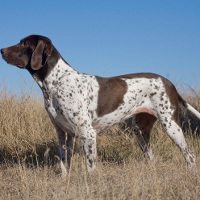Appearance of the Old Danish Pointer
|
| The male Old Danish Pointer is distinctive from the female. The male is larger and more muscular, while the female is lighter, slightly nervous and more animated. The Old Danish Pointer has a large, fleshy nose and wide, open nostrils. The nose should be dark brown, but can vary from brown to liver. Old Danish Pointers have low, medium-sized ears with broad, rounded tips. The front of the ear should hang close to the cheek. They have medium-sized eyes that should never appear too prominent or deep-set. Their eyes are dark brown and should never be light or hawthorn-colored. The Old Danish Pointer has a hard, short, dense topcoat. This hard coat should cover his whole body and should never appear too long or too fluffy. The skin is close to the body and not too thin. The skin on his body should be softer on his head and neck than on his body and legs. White with brown markings. |
Temperament of the Old Danish Pointer
|
| The Old Danish Pointer is a stable hunting dog, calm on the hunt and endowed with great determination and courage. He doesn't hurry when hunting. At home, he's a medium-energy dog who needs to spend time moving around during the day to keep him happy. Long walks in the streets or even playing in the dog park are good ways to expend some of his energy. All in all, he's an excellent family dog. He loves children and adults alike, and will quickly bond with his family. He is a little uncertain with strangers, especially when they approach his home. If your home has pet birds, you'll need to separate them and keep a close eye on your Old Danish Pointer, as he's a bird hunter. Other small pets should also be closely supervised around the Old Danish Pointer. Early socialization is an important part of training. |
Needs and activities of the Old Danish Pointer
|
| The Old Danish Pointer is a medium-energy dog, but not suitable for apartments or small houses. Daily exercise and mental stimulation are needed, and long walks or trips to the dog park are good ways to provide both. He would excel in a home where he can use his hunting prowess while becoming a family companion. Expect him to become unruly if left alone without daily interaction. Give him lots of new, interesting and interactive toys to keep him busy when you can't spend time with him. |
Maintenance of the Old Danish Pointer
|
| Maintaining the Old Danish Pointer is relatively easy, he needs minimal grooming and it usually only takes about 30 minutes a week to brush him. For grooming, he'll need a smooth brush and a metal comb. Because his coat is so hard, he's weather-resistant and should only be bathed a few times a year. When bathing, be sure to use a mild shampoo specially formulated for hard coats. Using the wrong shampoo can cause skin irritation or even coat damage. Although the Old Danish Pointer is not technically classified as a hypoallergenic breed, those without extreme allergies may not suffer from allergies. Be sure to check his ears weekly and clean them if necessary. His nails should be trimmed if necessary. Establish a routine dental care regimen that includes professional teeth cleanings to keep his teeth and gums healthy. |







 English (United Kingdom)
English (United Kingdom)